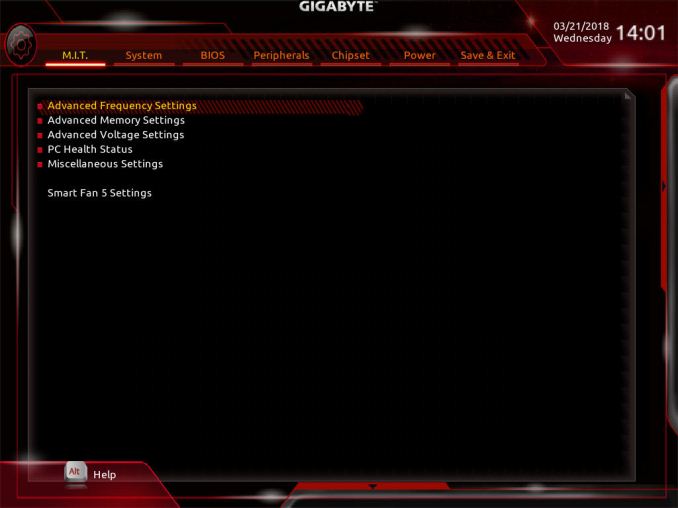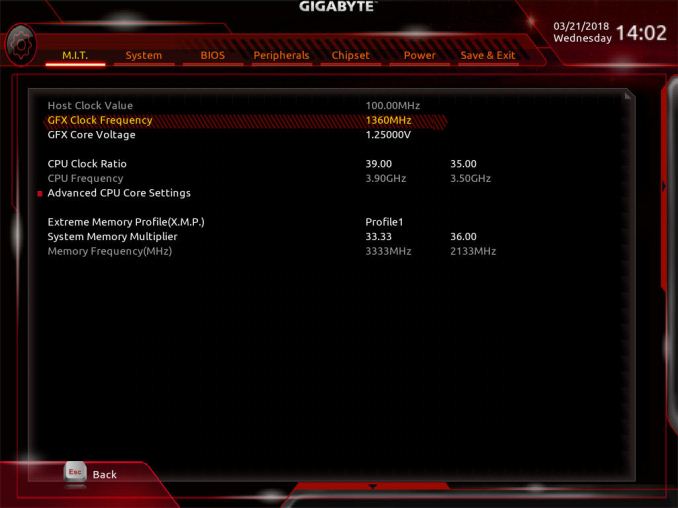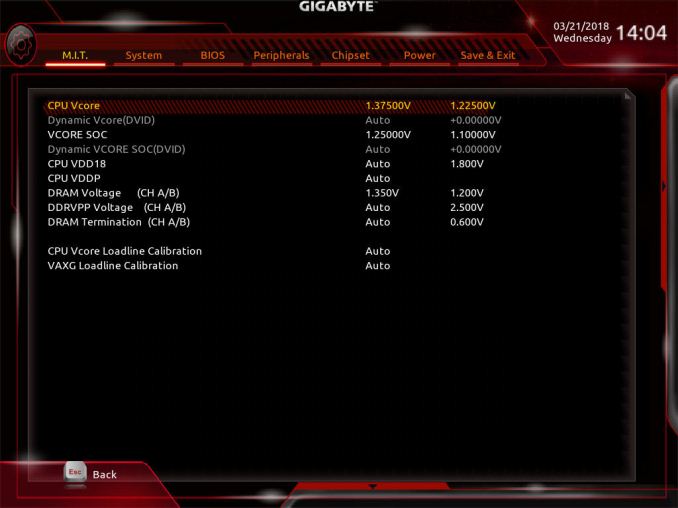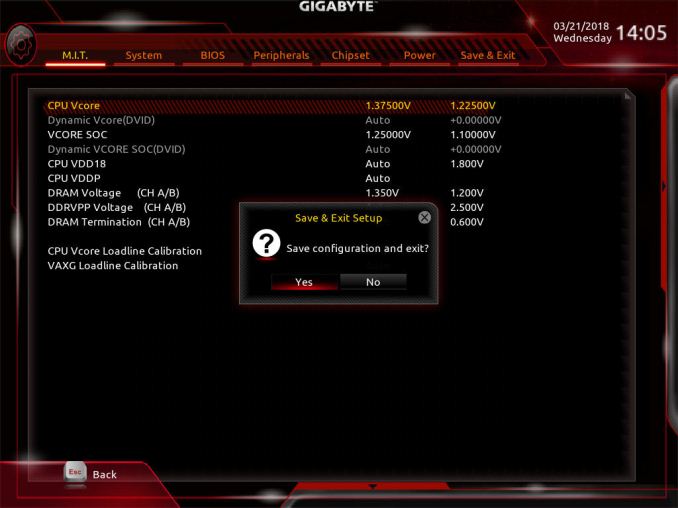Overclocking The AMD Ryzen APUs: Guide and Results
by Ian Cutress & Gavin Bonshor on April 16, 2018 2:30 PM ESTHow to Overclock With GIGABYTE UEFI BIOS
The GIGABYTE AX370-GAMING 5 BIOS uses more menus than most other BIOS implementations. Upon POST, the M.I.T screen is the entry point and it is here where the overclocking sub-menus are located.
The main settings are in the top three sub sections; advanced frequency settings, advanced memory settings and advanced voltage settings.
One thing I like (ed: I don't) about the GIGABYTE UEFI BIOS when overclocking is having the required settings to overclock one specific item in one particular area. In the advanced frequency menu, here is everything frequency related: CPU ratio, memory, and integrated graphics. Perhaps a little odd was also seeing the graphics voltage here as well, rather than only in the graphics menu.
The advanced voltage section provides all the voltages (except graphics), including the CPU and DRAM options. Users can also adjust the load line calibration. As with the MSI BIOS, once you adjust the voltage using the +/- keys it automatically sets it to 1.4V, which I feel is a tad too high for a 3.90 GHz overclock.
Even though the SoC voltage and GFX core voltage are essentially the same thing due to the fact that they are linked, they had to be set separately to the same value within this particular BIOS. Forgetting to change one doesn’t make any difference but setting both to the same value ensures peace of mind.
When applying the XMP profile in the advanced memory sub-menu, users can manually change the memory frequency (or strap) while keeping the latency timings applied as specified by the XMP profile.
Once the settings are configured, pressing F10 brings up the pop up to save and exit. Unlike some of the other motherboards, there is no confirmation window with the settings changed here: it is just a click yes and go.















63 Comments
View All Comments
Eidorian - Monday, April 16, 2018 - link
Alarms were going off in my head when it says in the article that the E2160 was from 2005. I have July 26, 2006 seared into my memory as Core 2 Duo Day. I see the E2160 IHS does say '05.https://ark.intel.com/products/29739/Intel-Pentium...
Ian Cutress - Monday, April 16, 2018 - link
IHS says 05, ARK says Q3 '06, CPU-World says May 2017.http://www.cpu-world.com/Releases/Desktop_CPU_rele...
jjj - Monday, April 16, 2018 - link
Pretty sure retail was early June 2007 (certain about year) for the Allendale Pentiums.jjj - Monday, April 16, 2018 - link
Some folks found it in retail in late May 2007http://www.overclockers.com/forums/showthread.php/...
Eidorian - Monday, April 16, 2018 - link
That looks good.https://web.archive.org/web/20070927002239/http://...
nathanddrews - Monday, April 16, 2018 - link
That 2200G is quite the little spitfire, relatively speaking. Not sure I would spend extra money for a better cooler on a budget gaming build, though. I would put that money toward an SSD or maybe a FreeSync display and then overclock as best I could.coolhardware - Monday, April 16, 2018 - link
I'm going with a 2200G for my son's first PC build. I remember my Pentium II 233 build with the help of Anandtech WAY back in the day, complete with SCSI HDD. It was a sweet system that lasted a long time.Now, back the AMD build, any mobo recommendations? I would like to keep it mini-itx if possible and I am leaning toward the GIGABYTE GA-AB350N:
https://amzn.to/2HFQAoS (~$109) but am open to suggestions.
Reliability is top concern and two digital video outs (HDMI, or DisplayPort, not analog DSUB). Starting with the integrated GPU but maybe down the road going discrete.
Thanks in advance for advice! :-)
coolhardware - Monday, April 16, 2018 - link
PS I remember Anand posting SO MANY motherboard reviews back when he was just a kid (and so was I). Back then I settled on a Tyan motherboard after his recommendation. :-)RaduR - Tuesday, April 17, 2018 - link
Back old ViA MVP3 platform . Yes we were kids and Anand was actually working here !gavbon - Tuesday, April 17, 2018 - link
There will be many more to come, don't worry about that!